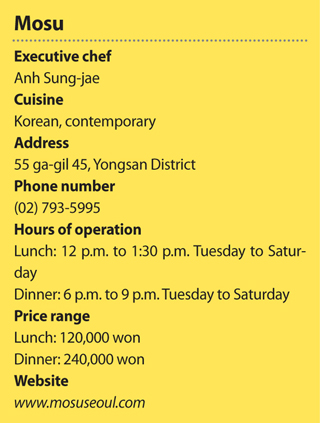For Mosu chef, originality is the key to success

Chef Anh Sung-jae of restaurant Mosu, above, prepares ingredients in the kitchen of his restaurant in Itaewon-dong, central Seoul. Presented at left are some of the signature dishes he is offering as part of his lunch menu. [LEE SUN-MIN, PARK SANG-MOON]
The chef of the one-year-old restaurant has already earned himself one star from Michelin Guide Seoul, an honor that he was also awarded while at his restaurant of the same name in San Francisco before he closed it down and moved back to Korea.
Originality is the chef’s goal and it can be seen through ideas he planted around his restaurant. Despite the hefty bill, the restaurant has started to see more regulars and now even serves lunch - which comes with a 120,000 won bill.
“I’m delighted to see that the diners coming to the restaurant have accepted the value I create and the expressions I wanted to share,” said Anh, adding that some thanked him for opening up the field for chefs and restaurateurs who have wanted to invest more into providing a better quality dining experience, which comes at a higher price.

“I wanted to differentiate my restaurant from others, and I thought this could be controversial, but I wanted the restaurant to be a place where our own value is given to the diners, and to pronounce our identity clearly.”
While many restaurants do add-ons to the base menu offered if diners want to substitute some of the dishes, Mosu only provides one menu.
His desire to pursue originality is evident in his food as well. One of Anh’s signature dishes is a presentation of ueong, burdock root. The particularly thin cylinder-shaped root vegetable is usually cut into thin slices and then marinated in soy sauce and served as banchan, or a side dish. However, the chef decided that he wanted to slice the outer layer to keep it curled and crispy after trying countless versions, in order to show that the ingredient, familiar to many Koreans, can be put into different forms and textures.
“The idea came from my understanding of molecular cooking, as well as experiences I [have had while] grilling on a stove,” said Anh, explaining how he brainstorms new ideas. Most of his ideas come from visual inspirations and the techniques he has learned and used throughout his cooking career. Ultimately, the goal is to make the ingredient taste good in a form that’s appealing to people’s eyes.
That’s the reason he focuses more on trying a variety of dining options outside of Korea. He wants to experience many visually entertaining dishes in order to get inspiration, and to eventually put Korean ingredients in a unique format that no one has imagined. He has also made abalone tacos and a adaptation of classic Korean-style ssam, or food wrapped in layers of leafed vegetables, served with tuna. Typically, ssam is a way to eat pork and beef, making the fish a surprise for most diners.
“What I look for is hedonic flavors and think about what can be considered hedonists’ food,” said the chef. “I travel to discover items that are common in that particular culture, so that I can make an adaptation of what I see abundant and what’s familiar to others so that the final dish becomes something very obviously from Mosu, [not from that culture], in the eyes, while the flavor still remains present.”
Making a new approach to Korean ingredients is Anh’s way of presenting Korean food. He tries to take inspiration from what’s classically traditional, instead of abruptly mixing Western styles with Korean styles.
He says he is not sure how to make the next “it” thing in Korean cuisine, but that getting closer to traditional Korean technique, just like how French chefs update and develop classic French techniques in their cooking, may bring out something in the future that’s not yet imaginable.
“Something that is Korean but not yet practiced is the key thing I think about,” the chef said.
“Comfort is the new luxury,” is something he has focused on since he opened Mosu in San Francisco. At his restaurant in Seoul, diners are invited to use their hands to eat and be themselves.
The staff walk diners to the door to send them off, just as your close friends and family would do when you visit their home. The entrance is at the top of some stairs, providing the feeling of a grandparents’ home in the suburbs, and a garden right outside the window gives diners the comfort of being away from the hustle and bustle of city life.
With the experience he has had in San Francisco and Seoul, Anh often think about where to go next. He dreams of Mosu Sydney or Mosu Hong Kong, picturing different opportunities in his head.
“It is not because Mosu Seoul is settled, but it is more of my constant thinking of what I can do and how I could make it work,” said Anh.
“I tend to [take on] very unrealistic challenges and think a lot about what can work in my brain.”
BY LEE SUN-MIN [summerlee@joongang.co.kr]










with the Korea JoongAng Daily
To write comments, please log in to one of the accounts.
Standards Board Policy (0/250자)